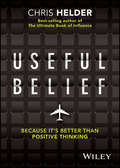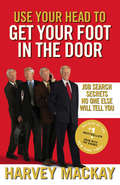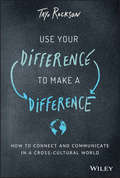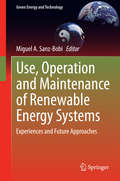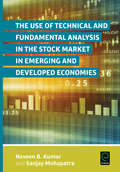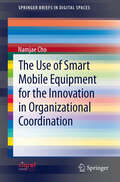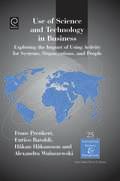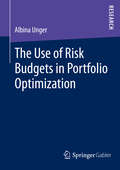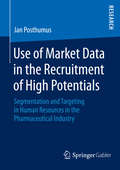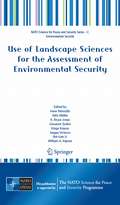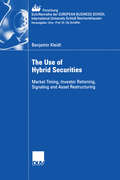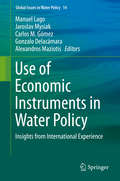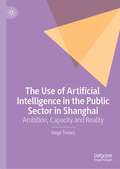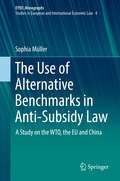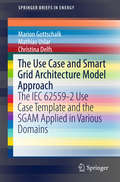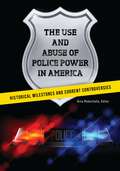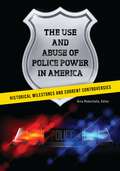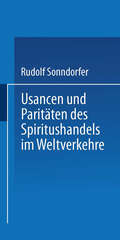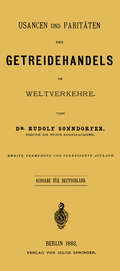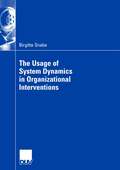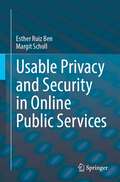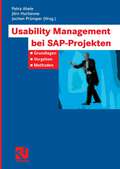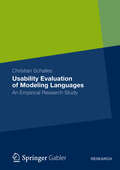- Table View
- List View
Useful Belief: Because It's Better Than Positive Thinking
by Chris HelderPositive thinking has had its time — the new way of overcoming life's challenges is USEFUL BELIEF Useful Belief turns the "be positive" industry upside down with a fresh and modern approach to achievement. Sometimes things in life are not positive. Sometimes bad things happen to good people. If you've had a nightmare of a year, the last thing you want to hear is "Be positive!" Instead, you need an actual strategy to dig yourself out, and a truly useful guidebook to show you where to go next. This is that guidebook. Through the engaging tale of a business traveller and the three significant encounters on his journey, this book takes you on a journey of your own — to self awareness, and an improved approach to business, parenting and relationships. You'll learn how thinking "useful" is better than thinking "positive", and you'll uncover the utility of your past, present and future challenges. You'll undergo a major shift in the way you solve your problems, and you'll learn how to navigate your way out of ambiguity and toward success. If you have challenges at work right now, just deciding to "be positive" will not fix them. Useful belief and strategy will. This book shows you how to frame your challenges to make them surmountable, and how to formulate an action plan for getting where you need to be. Learn a simple self-awareness strategy that turns problems into plans Discover the truth about "truth" and the importance of "useful" Go beyond positivity to actually fix personal and professional problems Uncover the valuable lessons you've learned from the challenges you've overcome Everything that has ever happened to you has happened for a reason. It doesn't matter if it's true, because it's useful to believe it is true. Useful Belief leads you toward the self-awareness and strategic outlook you need to achieve personal fulfillment and professional success.
Useful Belief: Because It's Better Than Positive Thinking
by Chris HelderPositive thinking has had its time — the new way of overcoming life's challenges is USEFUL BELIEF Useful Belief turns the "be positive" industry upside down with a fresh and modern approach to achievement. Sometimes things in life are not positive. Sometimes bad things happen to good people. If you've had a nightmare of a year, the last thing you want to hear is "Be positive!" Instead, you need an actual strategy to dig yourself out, and a truly useful guidebook to show you where to go next. This is that guidebook. Through the engaging tale of a business traveller and the three significant encounters on his journey, this book takes you on a journey of your own — to self awareness, and an improved approach to business, parenting and relationships. You'll learn how thinking "useful" is better than thinking "positive", and you'll uncover the utility of your past, present and future challenges. You'll undergo a major shift in the way you solve your problems, and you'll learn how to navigate your way out of ambiguity and toward success. If you have challenges at work right now, just deciding to "be positive" will not fix them. Useful belief and strategy will. This book shows you how to frame your challenges to make them surmountable, and how to formulate an action plan for getting where you need to be. Learn a simple self-awareness strategy that turns problems into plans Discover the truth about "truth" and the importance of "useful" Go beyond positivity to actually fix personal and professional problems Uncover the valuable lessons you've learned from the challenges you've overcome Everything that has ever happened to you has happened for a reason. It doesn't matter if it's true, because it's useful to believe it is true. Useful Belief leads you toward the self-awareness and strategic outlook you need to achieve personal fulfillment and professional success.
Use Your Head To Get Your Foot In The Door: Job Search Secrets No One Else Will Tell You
by Harvey MackayBestselling business author Harvey Mackay returns with an uplifting, amusing and jam-packed with proven tips book to guide you through the toughest job market in decades.The average person will have at least three career changes and ten different jobs by the age of 38. In this era of downsizing and outsourcing, you can never be sure your job will still exist in five years - or five weeks. So you'd better think of your career as a perpetual job search. That demands a passion for lifetime learning and the skills for relentless and effective networking.Mackay shows you how to be at your best when things are at their worst. His hard-hitting topics include: beating rejection before it beats you; warning signals that you might be losing your job; how to impress at interviews; negotiating the job you want, not the job they offer; taking advantage of the way bosses make hiring decisions; and blending the latest contact tools with old-fashioned face-to-face networking.Use Your Head to Get Your Foot in the Door is the definitive A-Z career resource for the rest of your life.
Use Your Difference to Make a Difference: How to Connect and Communicate in a Cross-Cultural World
by Tayo RocksonBecome more culturally competent in an increasingly diverse world Recent years have seen dramatic changes to several institutions worldwide. Our increasingly interconnected, digitized, and globalized world presents immense opportunities and unique challenges. Modern businesses and schools interact with individuals and organizations from a diverse range of cultural and national backgrounds—increasing the likelihood for miscommunication, errors in strategy, and unintended consequences in the process. This has also spilled into our daily lives and the way we consume information today. Understanding how to navigate these and other pitfalls requires adaptability, nuanced cross-cultural communication, and effective conflict resolution. Use Your Difference to Make a Difference provides readers with a skills-based, actionable plan that transforms differences into agents of inclusiveness, connection, and mutual understanding. This innovative and timely guide illustrates how to leverage differences to move beyond unconscious biases, manage a culturally-diverse workplace, create an environment for more tolerant schooling environments, more trusted media, communicate across borders, find and retain diverse talent, and bridge the gap between working locally and expanding globally. Expert guidance on a comprehensive range of topics—teamwork, leadership styles, information sharing, delegation, supervision, giving and receiving feedback, coaching and motivation, recruiting, managing suppliers and customers, and more—helps you manage the essential aspects of international relationships and cultural awareness. This valuable resource contains the indispensable knowledge required to: Develop self-awareness needed to be a cross-cultural communicator Develop content, messaging techniques, marketing plans, and business strategies that translate across cultural borders Help your employees to better understand and collaborate with clients and colleagues from different backgrounds Help teachers build safe environments for students to be themselves Strengthen cross-cultural competencies in yourself, your team, and your entire organization Understand the cultural, economic, and political factors surrounding our world Use Your Difference to Make a Difference is a must-have resource for any educator, parent, leader, manager, or team member of an organization that interacts with co-workers and customers from diverse cultural backgrounds.
Use Your Difference to Make a Difference: How to Connect and Communicate in a Cross-Cultural World
by Tayo RocksonBecome more culturally competent in an increasingly diverse world Recent years have seen dramatic changes to several institutions worldwide. Our increasingly interconnected, digitized, and globalized world presents immense opportunities and unique challenges. Modern businesses and schools interact with individuals and organizations from a diverse range of cultural and national backgrounds—increasing the likelihood for miscommunication, errors in strategy, and unintended consequences in the process. This has also spilled into our daily lives and the way we consume information today. Understanding how to navigate these and other pitfalls requires adaptability, nuanced cross-cultural communication, and effective conflict resolution. Use Your Difference to Make a Difference provides readers with a skills-based, actionable plan that transforms differences into agents of inclusiveness, connection, and mutual understanding. This innovative and timely guide illustrates how to leverage differences to move beyond unconscious biases, manage a culturally-diverse workplace, create an environment for more tolerant schooling environments, more trusted media, communicate across borders, find and retain diverse talent, and bridge the gap between working locally and expanding globally. Expert guidance on a comprehensive range of topics—teamwork, leadership styles, information sharing, delegation, supervision, giving and receiving feedback, coaching and motivation, recruiting, managing suppliers and customers, and more—helps you manage the essential aspects of international relationships and cultural awareness. This valuable resource contains the indispensable knowledge required to: Develop self-awareness needed to be a cross-cultural communicator Develop content, messaging techniques, marketing plans, and business strategies that translate across cultural borders Help your employees to better understand and collaborate with clients and colleagues from different backgrounds Help teachers build safe environments for students to be themselves Strengthen cross-cultural competencies in yourself, your team, and your entire organization Understand the cultural, economic, and political factors surrounding our world Use Your Difference to Make a Difference is a must-have resource for any educator, parent, leader, manager, or team member of an organization that interacts with co-workers and customers from diverse cultural backgrounds.
Use, Operation and Maintenance of Renewable Energy Systems: Experiences and Future Approaches (Green Energy and Technology)
by Miguel A. Sanz-BobiThis book addresses the use, operation and maintenance of new renewable energy systems, taking into account their integration in the current electrical markets and in the new emergent uses of energy. The book is based on practical experiences which present different perspectives about what occurs once an energy production plant based on sources of renewable energy is in production. Questions to be addressed include: how the energy produced is integrated into the current system of energy production, what is its consideration in the electrical market, what the impact is on society, how differential the strategies of operation and maintenance are with respect to conventional systems of energy production, etc.
The Use of Technical and Fundamental Analysis in the Stock Market in Emerging and Developed Economies (0)
by Naveen B. Kumar Sanjay MohapatraThis book gives a scientific and systematic approach to trading in emerging stock markets. As professional traders do not trade purely on the basis of the economic fundamentals, but also take into account market movements generated by other factors (noise trading), knowledge of technical analysis is important to anyone who would like to participate successfully in the stock market. Second, the existence of a skew towards reliance on fundamental analysis at longer horizons suggests that models based on economic considerations will be more important on the long run. Third, the existence of a skew towards reliance on technical analysis at shorter horizons suggests that models based on short term considerations (noise) will be more important in the short term. The present book gives a base for practitioners as well as students to learn the tricks of the trade through examples and case studies.
The Use of Smart Mobile Equipment for the Innovation in Organizational Coordination (SpringerBriefs in Digital Spaces)
by Namjae ChoRecent increases in uncertainty and speed of market change are driving the adoption of new intelligent mobile office systems. Organizational information systems paradigm suggests that a right match between organizational characteristics and the use of technology is critical in producing desired results. Following such perspective this study focused on the relationship between task characteristics and the use of mobile office systems with an intention to find out factors that affect the adoption of modern mobile office systems. The research results show that in performing tasks with high mobility users tend to use extensive mobile office functions. When the task has a high level of interdependency with external business partners, users relied on specialized mobile functions such as FFA, SFA and ERP. Highly volatile environment with many unexpected task changes caused an extensive use of task specific functions that help to solve problems at hand. Further, analyses of the differences of mobile office use by department showed that sales department used more communication functions than others, while administrative departments rely more on such task specific functions as mobile CRM and KM than others. Additional case study shows how the application of new technology the effectiveness of organizational coordination. Based on the research the concept of convergent coordination is suggested as well as the direction for future research.
Use of Science and Technology in Business: Exploring the Impact of Using Activity for Systems, Organizations, and People (International Business and Management #25)
by Hakan Sson Alexandra Waluszewski Frans Prenkert Enrico BaraldiThis book comprises a variety of examples of the use of science and technology in business, ranging from early computer use in the U.S. insurance industry to the present use of information technology in the Swedish furniture industry; from the classic UK fish and chip shop's use of white fish to Heathrow's Terminal 5-project; from new fishing net fibers to the cooling of chocolate at Cadbury's; from the development of new mobile wireless services to the creation of a genetic database on Iceland. The book shows the multifaceted and interactive character of the relationship between science and technology on the one hand, and business and innovation on the other. It explores this non-linear relationship through a selection of case studies and discusses its implications for science as well as for business. The economy of the use of sciences and technology, as well as the science and technology of economy, is given equal focus.
The Use of Risk Budgets in Portfolio Optimization
by Albina UngerRisk budgeting models set risk diversification as objective in portfolio allocation and are mainly promoted from the asset management industry. Albina Unger examines the portfolios based on different risk measures in several aspects from the academic perspective (Utility, Performance, Risk, Different Market Phases, Robustness, and Factor Exposures) to investigate the use of these models for asset allocation. Beside the risk budgeting models, alternatives of risk-based investment styles are also presented and examined. The results show that equalizing the risk across the assets does not prevent losses, especially in crisis periods and the performance can mainly be explained by exposures to known asset pricing factors. Thus, the advantages of these approaches compared to known minimum risk portfolios are doubtful.
Use of Market Data in the Recruitment of High Potentials: Segmentation and Targeting in Human Resources in the Pharmaceutical Industry
by Jan PosthumusIn his study, Jan Posthumus uses the grounded theory method to explore the implementation of marketing instruments such as segmentation and targeting in the recruitment of high potentials in the pharmaceutical industry. The implementation of these instruments can best be understood as the result of an interaction between four categories: the identified internal need for certain groups of high potentials; the scarcity of these groups of high potentials in the market; the attitudes, opinions, and strategies within human resources; and the technological capabilities. Depending on the situation, different recruitment instruments are used to recruit high potentials. However, the interviewees did not use an explicit high potential recruitment profile, though they implicitly search for varying combinations of high-potential characteristics such as: intelligence and agility, engagement, the ability to perform in various environments, and the ability to manage one’s energy levels.
Use of Landscape Sciences for the Assessment of Environmental Security (NATO Science for Peace and Security Series C: Environmental Security)
by Irene Petrosillo Felix Müller K. Bruce Jones Giovanni Zurlini Kinga Krauze Sergey Victorov Bai-Lian Li William G. KepnerThis book examines environmental security from the perspective of landscape sciences, identifying the forces that threaten environmental security at all levels. It stems from the last five years of the Pilot Study Project on Use of Landscape Sciences for Environmental Assessment sponsored by the NATO Committee on the Challenges of Modern Society. Readers explore concepts of environmental security from subjective and objective perspectives.
The Use of Hybrid Securities: Market Timing, Investor Rationing, Signaling and Asset Restructuring (ebs-Forschung, Schriftenreihe der EUROPEAN BUSINESS SCHOOL Schloß Reichartshausen #54)
by Benjamin KleidtBenjamin Kleidt analyzes why firms decide to issue hybrid securities. He provides insights into the financing behaviour of issuing firms with regard to operating and stock price performance prior and subsequent to hybrid security issues and shows that issuance motives for the use of different forms of hybrid securities are as diverse as available structures for this asset class.
Use of Economic Instruments in Water Policy: Insights from International Experience (Global Issues in Water Policy #14)
by Manuel Lago Jaroslav Mysiak Carlos M. Gómez Gonzalo Delacámara Alexandros MaziotisThis book assesses both the effectiveness and efficiency of implemented Economic Policy Instruments (EPIs) in order to achieve water policy goals and identifies the preconditions under which they outperform alternative (e.g. regulatory) policy instruments and/or can complement them as part of complex policy mixes. The development of a consolidated assessment framework helps clarify (and where possible, quantify) the effectiveness of each EPI on the basis of different criteria. Outcome-oriented criteria describe how the EPIs perform. They include intended and unintended economic and environmental outcomes and the distribution of benefits and costs among the affected parties. These steps consider the application of cost effectiveness and cost benefits analysis, e.g. to assess ex-post performance of the EPI. Process criteria describe the institutional conditions (legislative, political, cultural, etc.) affecting the formation and operation of the EPI studied (particularly relevant for assessing the possible impacts of using economic instruments), the transaction costs involved in implementing and enforcing the instruments and the process of implementation.Case studies from Cyprus, Denmark, France, Germany, Hungary, Italy, the Netherlands, Spain and the United Kingdom, as well as from Australia, Chile, Israel and the USA are presented in this book. A wide variety of EPIs are also covered, including water-pricing schemes (tariffs, environmental taxes, environmental charges or fees, subsidies on products and practices), trading schemes (tradable permits for abstraction and pollution) and cooperation mechanisms.
The Use of Artificial Intelligence in the Public Sector in Shanghai: Ambition, Capacity and Reality
by Diego TodaroThis book examines how Shanghai aims to improve public service provision by accelerating the use of artificial intelligence (AI) in the public sector. After clarifying the technical and social factors that shape the use of AI in this area, the book delves into the AI policy environment and AI ecosystem of Shanghai to gauge the city’s capacity to implement public sector AI applications. Then it examines how this capacity translates into real-world policy initiatives through the investigation of case studies. It highlights the analytical, operational and political capabilities that determine the strengths and limitations of such initiatives in deploying AI in the public sector, and it assesses their impacts on public service provision in Shanghai. By using the findings on Shanghai to gain a deeper understanding of key topics in public sector AI research, this book also contributes new knowledge about the use of AI to improve the provision of public services.
The Use of Alternative Benchmarks in Anti-Subsidy Law: A Study on the WTO, the EU and China (European Yearbook of International Economic Law #4)
by Sophia MüllerIn the debate over the treatment of China in trade remedy investigations, this book focuses exclusively on anti-subsidy law. As such, it brings a long neglected and often underestimated area of international trade law to the fore.Exploring the delicate relations between the WTO, the EU and China, it focuses on the current legal framework for the use of alternative benchmarks in anti-subsidy law and analyses the consequences that arise from its practical application in investigations against China. Scrutinizing recent developments in WTO anti-subsidy law, in particular the adoption of country-specific rules in accession protocols, the book reveals the shortcomings of the current approach and argues for fundamental reforms. Accordingly, the book provides academics and practitioners alike with vital insights into the legal evolution and practical application of alternative benchmark methodologies in the context of WTO and EU anti-subsidy law, while also putting forward a critical analysis of the status quo.
The Use Case and Smart Grid Architecture Model Approach: The IEC 62559-2 Use Case Template and the SGAM applied in various domains (SpringerBriefs in Energy)
by Marion Gottschalk Mathias Uslar Christina DelfsThis book introduces readers to the fundamentals of the IEC 62559 Use Case Methodology, explains how it is related to the Smart Grid Architecture Model (SGAM), and details how a holistic view for both architecture and requirements engineering can be achieved. It describes a standardized and holistic approach to requirements engineering for smart grid projects based on work conducted in the context of the EU M/490 standardization mandate. Over the last years, this method has been established in Europe as the basic building block of requirements engineering in the utilities sector. The authors present a canonical, structured approach that users can apply to the Use Case Methodology and the SGAM, as well as open tools for this purpose. The application in various domains outside the smart grid is also discussed, as it can be used for critical infrastructures or system-of-systems domains like Industrie 4.0 and Ambient Assisted Living. Accordingly, the book also presents various architecture models for different fields of application, like EMAM, SCIAM, RAMI 4.0, and MAF.
The Use and Abuse of Police Power in America: Historical Milestones and Current Controversies
by Editor Gina RobertielloProviding a timely and much-needed investigation of how U.S. law enforcement carries out its public safety and crime fighting mandates, this book is an invaluable resource for students, educators, and concerned citizens.Does America face an epidemic of police officers abusing their powers and disregarding constitutional rights, especially in communities of color? Or are such accusations unfair, especially given the enormous challenges of enforcing the law in 21st-century America? This book provides a unique frame of reference for understanding how some of the issues between the police and the public emerged, identifying events that have shaped current relationships between the police and the public, as well as the public's expectations and perceptions of the police.An authoritative resource for understanding modern law enforcement and its relationship with American communities, this volume addresses subjects including the legal underpinnings of various law enforcement actions and practices; the so-called militarization of police departments; the increased use of force and surveillance to combat crime and terrorism, and to generally "keep the peace"; and the perspectives of Black Lives Matter activists and other critics of American law enforcement. The entries provide readers with expert analysis of current topics related to the intensifying debate about the American police state; examine the scope of law enforcement issues that have existed for centuries, and explain why they continue to exist; and cover new mandates for exercising police power, enabling readers to critically analyze what is presented to them in the media. Included throughout the book are excerpts from important laws, speeches, reports, and studies pertaining to the subject of the use and abuse of police power in the United States
The Use and Abuse of Police Power in America: Historical Milestones and Current Controversies
by Gina RobertielloProviding a timely and much-needed investigation of how U.S. law enforcement carries out its public safety and crime fighting mandates, this book is an invaluable resource for students, educators, and concerned citizens.Does America face an epidemic of police officers abusing their powers and disregarding constitutional rights, especially in communities of color? Or are such accusations unfair, especially given the enormous challenges of enforcing the law in 21st-century America? This book provides a unique frame of reference for understanding how some of the issues between the police and the public emerged, identifying events that have shaped current relationships between the police and the public, as well as the public's expectations and perceptions of the police.An authoritative resource for understanding modern law enforcement and its relationship with American communities, this volume addresses subjects including the legal underpinnings of various law enforcement actions and practices; the so-called militarization of police departments; the increased use of force and surveillance to combat crime and terrorism, and to generally "keep the peace"; and the perspectives of Black Lives Matter activists and other critics of American law enforcement. The entries provide readers with expert analysis of current topics related to the intensifying debate about the American police state; examine the scope of law enforcement issues that have existed for centuries, and explain why they continue to exist; and cover new mandates for exercising police power, enabling readers to critically analyze what is presented to them in the media. Included throughout the book are excerpts from important laws, speeches, reports, and studies pertaining to the subject of the use and abuse of police power in the United States
Usancen und Paritäten des Getreidehandels im Weltverkehre: Ausgabe für Deutschland
by Rudolf SonndorferThe Usage of System Dynamics in Organizational Interventions: A Participative Modeling Approach Supporting Change Management Efforts
by Birgitte SnabeBirgitte Snabe analyzes how system dynamics modeling can be used in learning processes that focus on the transfer of the insights and reasoning behind a strategy forming process. In a second step, she shows how it can support the refining of implementation plans. A case study in action research tradition completes the theoretical discussions. Its subject is the building up of a large international company’s R&D resources in low-cost countries.
Usable Privacy and Security in Online Public Services
by Esther Ruiz Ben Margit SchollThis practice-oriented book is a unique guide to the implementation of usable, privacy-compliant and secure online services in the area of e-government. Beginning with a clarification of basic concepts of usability, data privacy, and cybersecurity, the book provides lucid explanations of different methods (quantitative, qualitative, and mixed methods) that can be applied in the practice of designing, developing, and evaluating online public services in light of both usability criteria and data privacy and IT security compliance. A number of examples and exercises are included as well as awareness-raising measures that can serve as orientation both for practitioners and for teaching purposes. There is also a concise glossary of terms along with recommendations for further reading.This book provides comprehensive coverage of usability, data privacy and information security topics. At the time of going to press, it is also up to date with respect to the implementation of the EU Single Digital Gateway regulation. It is therefore aimed at anyone interested in understanding the principles of usable privacy and information security and in ways of contributing to the design, development, and evaluation of online public services that satisfy the needs of the public. The book’s audience thus includes not only students in the areas of e-government or public administration but also professionals developing online services or e-government applications.
Usability Management bei SAP-Projekten: Grundlagen - Vorgehen - Methoden
by Bernd Stein Andreas Blume Stefanie Floegel Gerd Waloszek Anne Jansen Ulrich Kreichgauer Reinhard Linz Cornelius MüllerBisher gab es noch keine dezidierte Vorgehensweise für Usability Management bei SAP-Projekten, weder für Entscheidungsträger noch für Berater. Gleichwohl sind Benutzerproduktivität, Total Cost of Ownership eines SAP-Systems und Arbeits- und Gesundheitsschutz Themen, die in den Unternehmen ernst genommen werden. Entscheidungsträger und SAP-Berater in Unternehmen erhalten mit diesem Buch Anleitung und Anregung für Usability Management bei SAP-Projekten in der Praxis. Sie erfahren Wege, wie die Produktivität der Software durch Einbeziehen der Benutzer in die Gestaltung erhöht werden kann und wie man professionell auf Benutzeranforderungen reagiert.
Usability Evaluation of Modeling Languages
by Christian SchallesThe usability of graphical modeling languages has not been explicitly considered in past research. Most usability evaluation surveys are mainly focusing on applications, websites, software and technical products. Usability has not been focused on within the development of current graphical languages for conceptual modeling. Consequently, the impact of graphical modeling languages on users as well as the output resulting from their application is not clear. Dr. Christian Schalles focuses on an empirical usability evaluation of graphical modeling languages in business process and software modeling.
